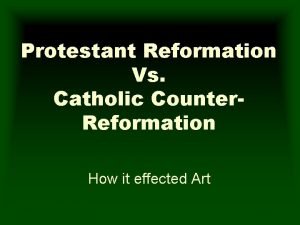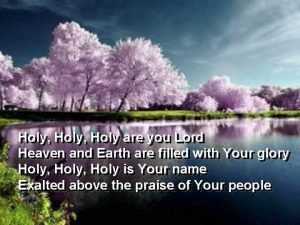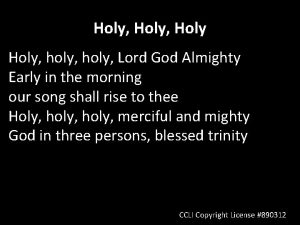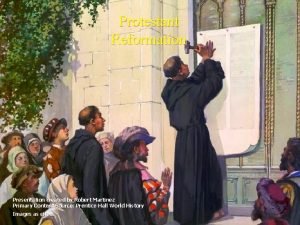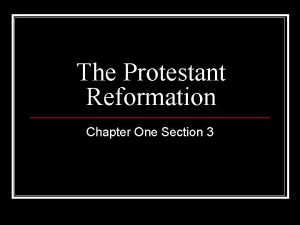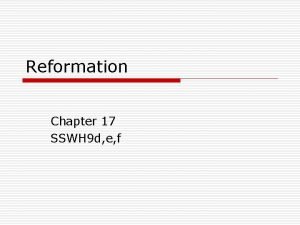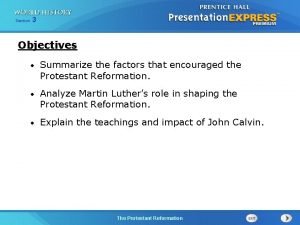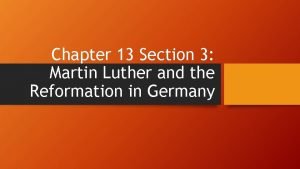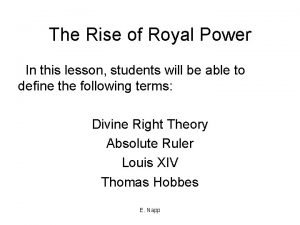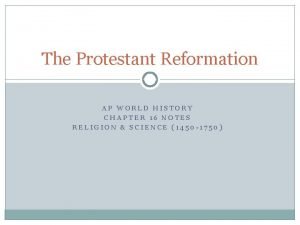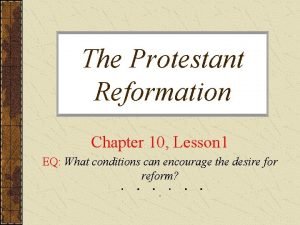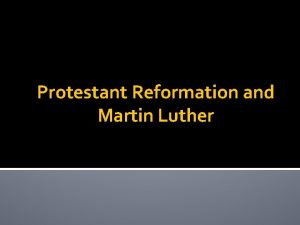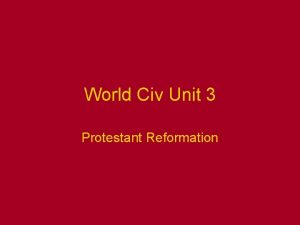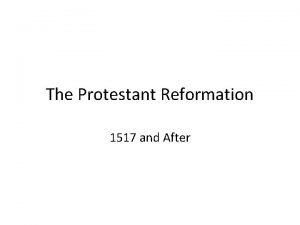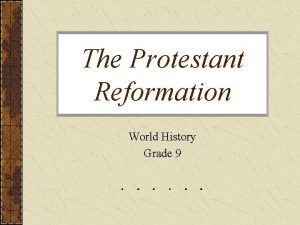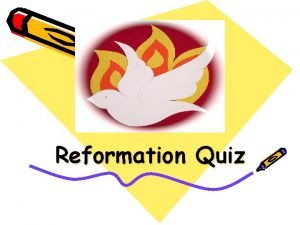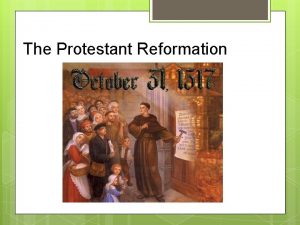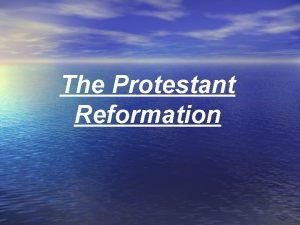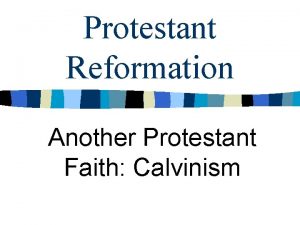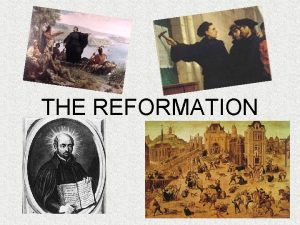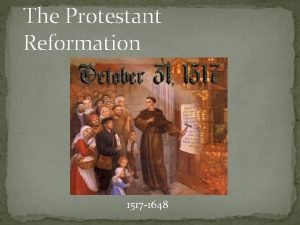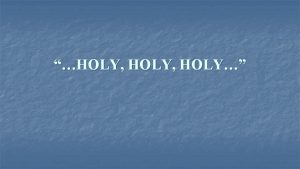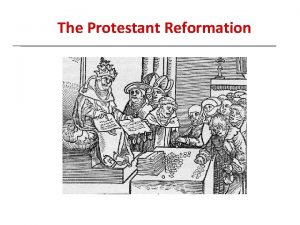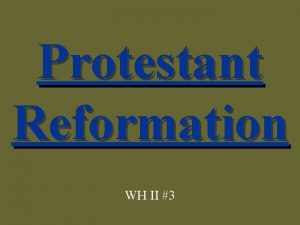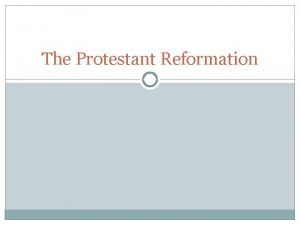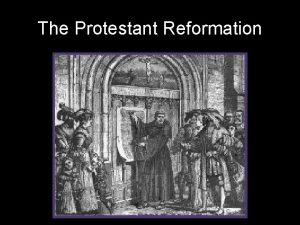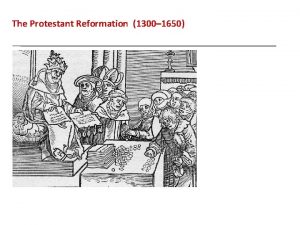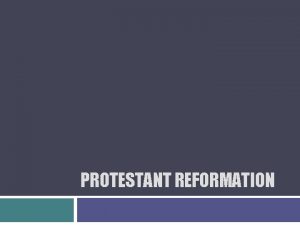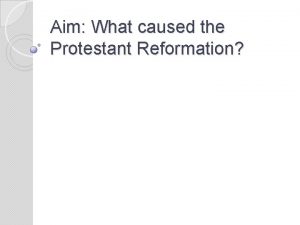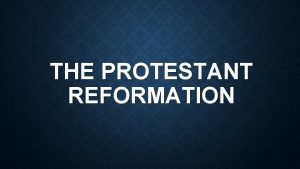Protestant Reformation Holy Roman Empire in 1500 Located
















- Slides: 16

Protestant Reformation

Holy Roman Empire in 1500 • Located in modern day Germany • Not a united nation but a patchwork of independent states • Each State had its own Prince • The Ruler of the Holy Roman Empire was Charles V (Catholic)

The Catholic Church in 1500 • The Catholic Church was the most powerful institution in Europe • Held the monopoly on information and education and owned a great deal of property • People resented the wealth of the Church • The Church and Clergy did not pay taxes • The Church was corrupt!

The Catholic Church Headquarters = Rome Power of the Pope: • Head of the Catholic Church • Occupies God’s position on earth (above any earthly power) • Infallible

What Catholics Believe The Seven Sacraments: Baptism Eucharist (mass/communion) Confirmation Confession Anointing of the Sick – Last rites Holy Orders – men to become priests Marriage

Height of Papal Corruption Who? Pope Leo X 1513 -1521 What did he do? Depleted Papal coffers Money needed for St. Peter’s reconstruction Solution: Sale of Church offices Sale of indulgences Pope Leo X with cardinals Giulio de' Medici and Luigi de' Rossi by Raphael

• Prior to the Reformation all Christians were Roman Catholic • The Reformation was an attempt to REFORM the Catholic Church • Martin Luther and others wanted to get rid of the corruption and restore people’s faith in the church, not start a separate church

Martin Luther 1483 -1546 • • Born in 1483 in Eisleben, Germany Became a monk in 1505 Moved to Wittenberg, Germany in 1511 Troubled by the sale of indulgences

Luther’s Issues with the Catholic Church • Luther had two major problems with the Catholic Church: • Indulgences • Justification • Luther believed that the Bible was the ultimate authority - not the pope or clergy • Of the seven sacraments only Baptism and Holy Communion were found in the Bible • He also came to believe in justification through faith alone not faith and good works

What was an Indulgence? • A Papal pardon for sins • A lessening of the time a soul would have to spend in purgatory – Purgatory = a place where souls too impure to enter heaven atoned for sins committed during their lifetime • According to Luther, indulgences had no basis in the Bible and the Pope had no authority to release souls from purgatory

Martin Luther’s Actions Luther posted his 95 Theses on the door of the castle church in Wittenberg, Germany on October 31, 1517 His intent was to reform the Catholic Church, not create a separate one

How Did Word Spread So Quickly? Gutenberg’s Printing Press made it possible for Luther to spread his beliefs Copy of Luther’s 95 Theses from Gutenberg's Press

Reaction To Luther • Gained support from people (including the princes in the HRE) • Gained criticism from Church • Millions converted

Branches of Christianity CHRISTIANITY Protestant Roman Catholicism Eastern Orthodox Lutheran Martin Luther Anglican Henry VIII Calvinist John Calvin Puritan Huguenots Presbyterian

The Protestant Reformation Map

Results • In the end reformers like Luther established their own non-Catholic traditions • The Reformation caused a permanent split in Christianity with the formation of new Protestant faiths • The Roman Catholic Church lost many members of the church as well as power in Europe
 Catholic reformation vs counter reformation
Catholic reformation vs counter reformation You are holy lord of heaven and earth
You are holy lord of heaven and earth Holy holy god almighty the great i am
Holy holy god almighty the great i am Protestant reformation
Protestant reformation The protestant reformation worksheet answers
The protestant reformation worksheet answers Peace of augsburg def
Peace of augsburg def What factors encouraged the protestant reformation?
What factors encouraged the protestant reformation? Chapter 13 section 3 the protestant reformation
Chapter 13 section 3 the protestant reformation Protestant reformation
Protestant reformation Chapter 16 lesson 2 the spread of protestantism
Chapter 16 lesson 2 the spread of protestantism Chapter 16 lesson 1 the protestant reformation answer key
Chapter 16 lesson 1 the protestant reformation answer key Protestant
Protestant Unit 3: martin luther & the protestant reformation
Unit 3: martin luther & the protestant reformation Protestant beliefs
Protestant beliefs Protestant reformation map
Protestant reformation map Crash course protestant reformation
Crash course protestant reformation The protestant reformation quiz
The protestant reformation quiz
